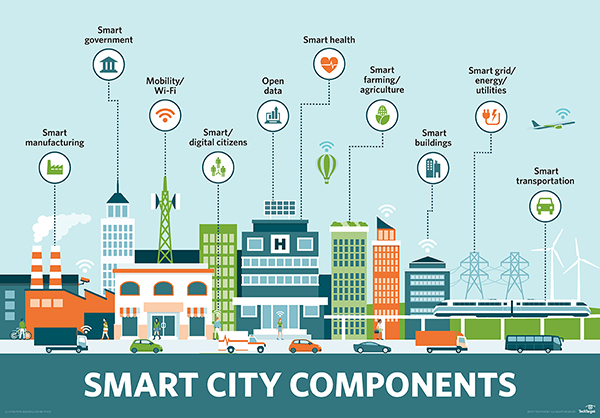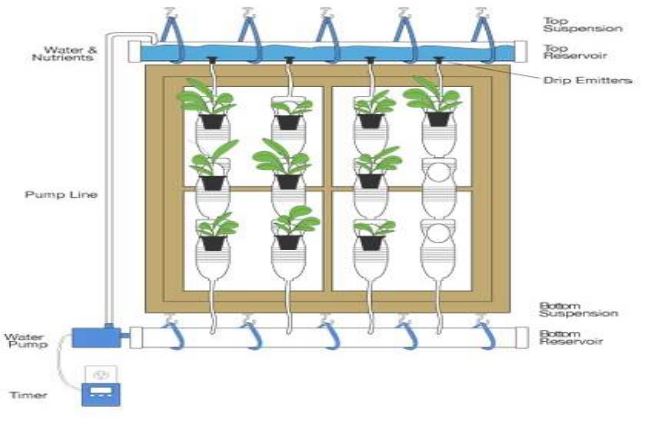Over the last couple of weeks, we’ve looked at the current state of affairs, what vertical farming is and what it can be, some of the technologies that drive vertical farming, farming insects as a food source and how vertical farms can produce more than food. We’ve explored how vertical farming can be implemented in the home and how vertical farms can be made intelligent through robotics and IOT. Any city of the future would benefit immensely from the inclusion of one or more vertical farms, and indeed the wider environment and communities would benefit too. But vertical farms on their own are not enough to save the environment or the people and creatures living on the planet – to achieve that, our efforts need to be bigger and grander. Vertical farming still plays a big role in those efforts, by being part of a smart, eco-city.
A what now?
So what is an eco-city? Well, depending on where you look, you will get different answers, but I think that the working definition accepted by organisations like the Ecocity Builders and the International Ecocity Framework and Standards Advisory summarises it nicely:
An Ecocity is a human settlement modelled on the self-sustaining resilient structure and function of natural ecosystems. The ecocity provides healthy abundance to its inhabitants without consuming more (renewable) resources than it produces, without producing more waste than it can assimilate, and without being toxic to itself or neighbouring ecosystems. Its inhabitants’ ecological impact reflect planetary supportive lifestyles; its social order reflects fundamental principles of fairness, justice and reasonable equity.
As mentioned previously, during humanities beginnings, we were part of natural ecosystems. As a species, we grew, and our advancements and growing numbers moved us further and further away from those ecosystems, eventually destroying the ones around us – a process which continues to this day. An eco-city is a reinvention of how we live, which doesn’t sacrifice our modern conveniences (if anything, adding to them) and returning to a sustainable, ecological centric way of living. So what are the key areas of an eco-city?
- Renewable energy generation and smart energy consumption
- Renewable resource generation and smart resource consumption
- Healthy resource quality of food, water and air
- Efficient and reusable waste management
- Efficient and readily available social requirements like housing, education, health, safety and transport, for all parts of society
- Smart management of energy, transport, resources and people, as well as communication between those systems
- Intelligent and efficient city design to maximise the accessibility and efficiency of the above points
Energy
Energy is a huge cornerstone of our modern way of life, and even more so for future life in eco-cities. For example, we are seeing a transition toward electric transport, which will increase the demand for energy as the technology propagates itself through society. A big problem with cities currently is that much of their energy is generated by non-renewable sources, like coal and gas, or through risky means such as nuclear fission. To top it off, a lot of the energy is wasted because it is used inefficiently. So how do we solve this?
Renewable Generation
The first key step is to switch a 100% of a city’s energy sources to renewable ones. This includes sourcing energy from:
- Solar, via solar panels built onto rooftops and open spaces, and built into windows and roads
- Wind, via wind turbines
- Hydro, via dams and rivers
- Tidal, via tidal cycles
- Biofuels produced by sources like algae
- Nuclear Fusion
Smart Consumption
The second key step is how that renewable energy is used. A city-wide smart electrical grid would be capable of talking to all of the buildings, the appliances within those buildings, with the energy generation sources, and with the cities transport. By knowing exactly how much energy is available and how much is required, energy could be moved around the grid to maximise its usage, buildings and appliances could be switched to low power modes dynamically as required, balancing the needs of everything within the city. Because the buildings themselves would be generating energy, many buildings would be self-powering and if they were generating more energy than they were using, the extra energy could be shared with other buildings or the grid in a process called peer to peer energy. Vertical Farms would be a key user and contributor of the smart grid.
Resources
Cities are big consumers of resources, or more specifically, the people inside the cities are. The three key resources are food, water and air.
Food
The need for food is a key one, a role which vertical farms would be filling. In order to adequately provide for a cities population, there are two things that are needed – the right amount of food being produced and that food being efficiently distributed and consumed. As far as production is concerned, a rough calculation can be run.
(T x V) + ((T x M) x N) = Y
How does the equation work? Well;
- T = total calories consumed per day
- V = is the percentage of those calories that are plant-based
- M = is the percentage of those calories that are meat based
- N = the number of plant calories needed to grow the meat
- Y = is the total amount of plant-based food that needs to be grown to provide T
plugging some values into the equation like such:
- T = 2,500 (an average daily calorie intake – varies from person to person)
- V = 0.9 (i.e. a 90% plant-based meals)
- M = 0.1 (i.e. 10% meat based meals)
- N = 16 (based on the average plant calories per calorie of meat from beasts like cattle or sheep)
(2,500 x 0.9) + ((2,500 x 0.1) x 16) = 6,250
- Y = 6,250 total plant calories required per day to feed one person
Ready for another calculation? (C x D) / M = L
- C = Calories required per day, in this case, 6,250
- D = number of days in the year, 365
- M = average square meters require growing 1000 calories over the course of a year – which is 1m²
- L = (6,250 x 365) / 1000 = 2,281.25 meters squared
Thus 2,281.25m² is required to grow 2,500 calories per day for one person, 365 days per year. To produce food on such exact figures is risky, as some people will eat more, some will eat less, and if you don’t have enough food, you end up with food shortages, which is not a desirable outcome. Thus the equation should grow more calories than the average person needs, let’s say 2,700 calories per day. This brings our land total up to 2,463.75m².
In a world where space is at a premium, and even more so within a city even more so, and again more so within a vertical farm, this doesn’t bode well. In a previous blog, we looked at how insects as a protein source would be a more sustainable than continuing to grow beef. For an equal amount of beef protein, cricket required 12 times less food to produce. If we divide 16 by 12 we get approximately 1.33. If we plug that into the calculation for 2,700 required calories per day, we end up with 2,789.1 calories that need to be grown each day, which only requires 1,018m² – a far more sustainable amount.
So how much could theoretically be grown in a vertical farm? Well, if a vertical farm was build that had a usable floor area 100m wide by 100m long, you would have an area of 10,000m². If this particular vertical farm used a-frames that were 0.5m wide, 1m long and 2.5m tall, each side of the A-frame would have a growing area of 5m². Allowing for 0.5m aisles between a-frame rows, 50% of the space can be filled with A-frames, which provides roughly 25,000m² of growing space in the 100m by 100m floor area. If the food produced was solely going toward feeding people, each floor could feed approximately 25 people, every day, each day of the year. That figure doesn’t take into account the increased efficiency of growing indoors – while it would vary from plant species to plant species, as a general rule of thumb, one acre indoors is equivalent to 10 outdoors, although, for certain foods, like strawberries, this can go as high as 1:30. For reference, 25,000m² is about 6.2 acres.
Water & Air
Water and air are simpler that food, as both are more readily available – the main goal here would be quality. Many large cities around the world suffer from polluted water and polluted air, however, in an eco-city that could be very different. If renewable energy sources were powering cities and if all transport was electric, the air would already be substantially cleaner than it currently is in a lot of places. As for water, cities could be a lot more efficient with their water consumption, not only in its usage but also in how it processes and recycles wastewater.


















